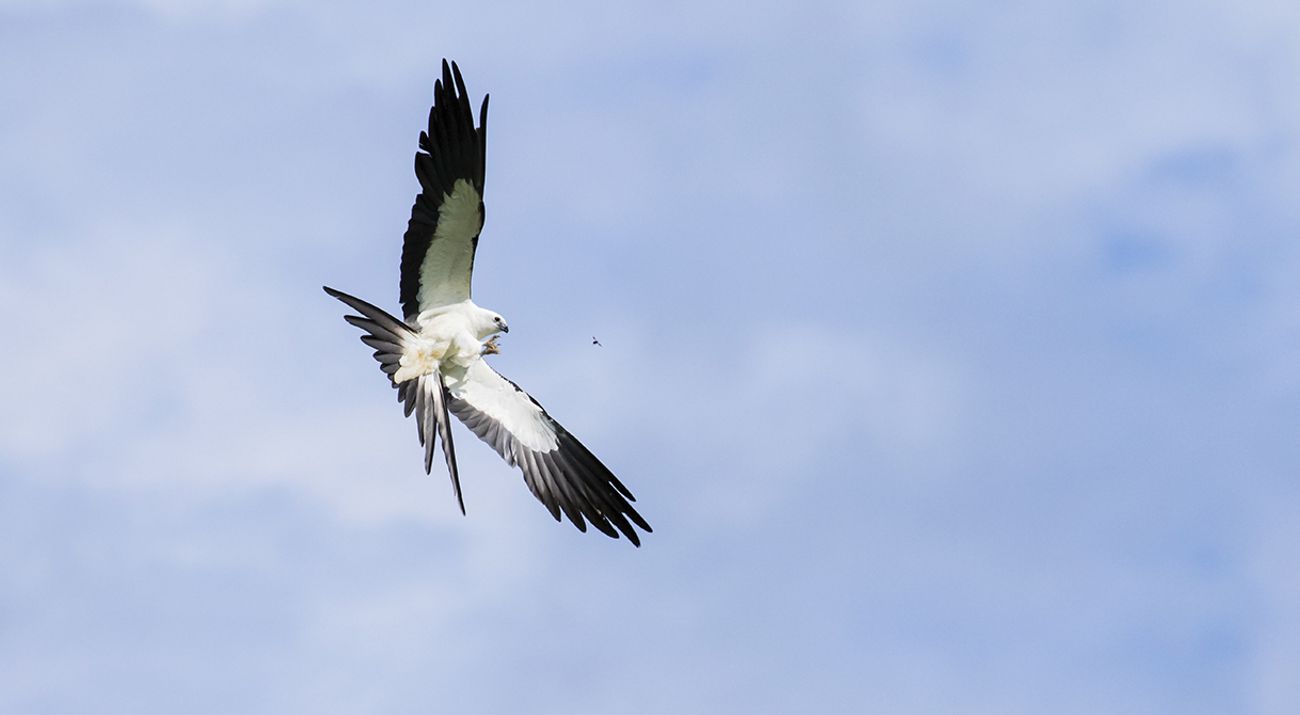A Safe Place to Land
Climate change is eroding the swallow-tailed kite's habitat.
April/May 2016
Maria Whitehead yanks her feet out of the water as something crashes into Bull Creek next to the boat. Seconds later, a 10-foot-long alligator surfaces a few yards away. As the prehistoric reptile glides off, leaving a sinuous wake in the tannin-brown river, Whitehead casually retrieves her binoculars and goes back to watching a nest of swallow-tailed kites near the top of a soaring pine.
A project director for The Nature Conservancy in the South Carolina Lowcountry, Whitehead seems unfazed by nearly losing a toe on the job. So does Craig Sasser, manager of the Waccamaw National Wildlife Refuge. Wading into primeval cypress swamps, scaling 100-foot pine trees, paddling up tidal rivers through clouds of insects in triple digit heat: These are all part of researching swallow-tailed kites, a spectacular but poorly understood raptor.
Swallow-tailed kites are built like gliders, with huge wings and small, streamlined bodies. They rarely flap their wings; instead, they soar effortlessly, changing course with minute adjustments of their distinctive forked tails. They feed on the wing, snatching dragonflies and other insects out of the sky. Watching a swallow-tailed kite in flight is to be entranced. Even the Peterson Field Guide seems almost effusive about the bird, calling it “a sleek, elegant, black-and-white hawk that flies with incomparable grace.”
But admiration alone is not driving the urge to learn more about these rare birds. Subject to a variety of pressures, the kites have already undergone a historic population crash. Now, new threats are emerging that require land managers not only to understand the birds better but also to change their conservation approaches to preserving the near-coastal habitats that sustain them.
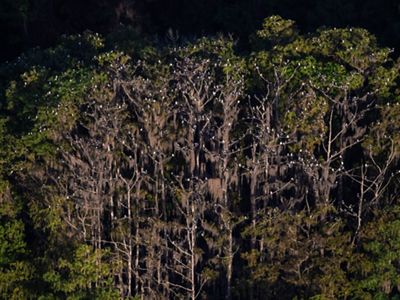
Swallow-tailed kites once nested in 21 states. Records from the 1800s show nesting pairs as far up the Mississippi Valley as Minnesota and Wisconsin. Then the population underwent a sudden decline. By 1940, the kite’s range had shrunk to seven states, from South Carolina to Texas—and the reason was unclear. Nor did anyone know how many birds remained or where exactly they flew when they migrated south.
“The birds are really hard to understand because they’re hard to put your hands on,” Whitehead says. Finding their nests—well-hidden in the tops of pines—is difficult. Catching birds to tag with radio collars is tricky. Satellite tracking was impossible until recently, when transmitters got small and light enough to be affixed to the birds without hindering them. But the more researchers have learned about kites, the more concerned they have become. The species is now listed as endangered in South Carolina, although it is not on the federal list.
“By definition they’re a little more vulnerable than some other species,” says Jim Elliott, founder and executive director of South Carolina’s Center for Birds of Prey, which maintains a database of swallow-tailed kite sightings.
A number of factors contribute to that vulnerability: The birds do not reach breeding age for three to four years, and females do not breed every year. Nesting adults and their young are subject to predation by great horned owls. They have high mortality on their migration between the southern United States and southern Brazil—especially in the spring, when they fly north across the Gulf of America (Gulf of Mexico) and can be swept off course by storms. And there just aren’t very many of them. Past estimates have guessed that there might be only a few thousand breeding pairs left in the country, scattered from South Carolina to Texas.
Then there’s habitat loss. Cypress swamps and other freshwater forested wetlands where the birds nest have been dwindling for centuries. Since the 1700s, about half the nation’s wetlands have disappeared, threatened by agriculture, logging, dams, dredging and invasive species, as well as natural disturbances like hurricanes. The rate of wetlands loss has wavered, but it hasn’t stopped: A 2011 U.S. Fish and Wildlife Service report found that wetland losses were outdistancing gains, especially in freshwater forested wetlands.
Such concerns brought a group of researchers together in the 1990s to study kites. The multi-state Swallow-Tailed Kite Conservation Alliance has more than 30 partners from an alphabet soup of state and federal natural-resources agencies, timber companies and nonprofits, including the Conservancy and Audubon. Over the past couple of decades, the group’s efforts have significantly expanded the understanding of swallow-tailed kites.
One thing that has become clearer is how social the birds are—a rarity for raptors. About an hour after her gator encounter, Whitehead spots a large group of kites foraging over the cypress swamp. Wheeling acrobatically, they are all the more striking for their numbers.
“A social raptor—it doesn’t even sound possible,” Whitehead says. “But at every phase of the annual cycle, they’re showing social behavior.”
Kites forage in groups. They nest in “neighborhoods” and roost in groups ranging from dozens to more than one thousand prior to migrating. This, too, makes them vulnerable, because being social ties large groups of them to a single place. If the places where they forage, nest and roost are not protected, the population could decline further.
However, preserving habitat for kites is not as simple as figuring out where the birds are roosting right now. It’s also necessary to determine where they could thrive in the future.
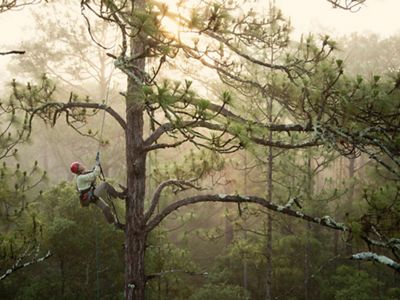
The day after her run-in with the alligator in South Carolina, Whitehead is unloading kayaks at a Black River boat landing when a man in a truck drives up.
“I’ve seen five of those birds,” he says. Whitehead doesn’t need to ask what he means, as all the local boat landings have signs depicting a swallow-tailed kite and asking, “Have you seen this bird?” Sightings are logged in a database managed by the Center for Birds of Prey, an alliance partner. Whitehead is pleased: Citizen science can help record not just current species range but how it’s changing. She smiles as the man rhapsodizes about kites, and then asks if any might be nesting on his land.
He allows as how they might, and tells her, before driving off, that “they’re good luck.”
Property owners like him are potential allies for Whitehead in her quest to preserve kite habitat. She works throughout Winyah Bay and its tributaries, the Waccamaw, PeeDee and Black rivers. In South Carolina, the Conservancy and its partners—including many local landowners—have protected more than 1 million acres of current and potential habitat in the coastal plain. The protected acres include those with conservation easements and preserves like the Waccamaw National Wildlife Refuge, which may have the highest density of nesting swallow-tailed kites in the state.
But now a new peril looms: salinity intrusion linked to climate change. As sea levels rise, ocean tides push the “salt wedge” farther inland. This is the zone where saltwater pushes upstream in a wedge under the freshwater flowing out to sea. On South Carolina’s Sampit River, acres of dead cypress trees testify to salt’s creep upriver. Models show large swaths of freshwater cypress swamp being replaced by the spartina grass of a salt marsh.
“We put the best science we had behind the creation of the wildlife refuge,” Sasser says of the nearly 20-year-old Waccamaw, “but we had no idea about sea-level rise.” The threat was starting to be understood at the time, but its effects in the low-lying freshwater swamps were yet to be seen.
The Conservancy and Waccamaw National Wildlife Refuge are now working with the U.S. Geological Survey and university partners to better understand the habitat transition that’s under way. As this new understanding emerges, conservation strategy is also changing.
“Thousands of acres of protected kite nesting habitat will be the first to transition to brackish marsh,” Whitehead says. “To protect the future of kites, we’re prioritizing permanent protection of freshwater forested wetlands that are upstream of the advancing salt wedge.”
In other words, we have to target the areas kites need even before they need them. On the Black River, hundreds of acres of future habitat have been protected through conservation easements. And recently, the Conservancy partnered with the town of Conway, South Carolina, to expand its recreational corridor along the Waccamaw refuge while also adding more upstream habitat to the refuge itself.
“When possible, we’re protecting upstream freshwater forests that are already occupied by nesting kites,” Whitehead says. “The bird’s unwavering attachment to place takes some of the guesswork out of where kites might be in the future.”
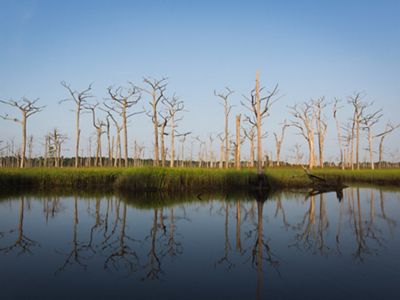
“They keep coming back to the same places every year,” Ken Meyer says from the front seat of a Cessna as it taxis through the predawn gloom in Clewiston, a small town near Florida’s Lake Okeechobee. “In a rapidly changing world, that’s a blessing and a curse.” Executive director of the Avian Research and Conservation Institute, based in Gainesville, Florida, Meyer is another member of the Swallow-Tailed Kite Conservation Alliance. He has been studying the birds for more than 25 years. Meyer conducts annual roost counts and tracks them by radio and satellite. Now he’s putting the data to use.
Swallow-tailed kites roost en masse before migrating—and the large majority of them, Meyer estimates, do so in Florida. It’s a crucial time for them as they load up on calories for an exhausting 5,000-mile flight across the Gulf of America and down to the tropical forests of southern Brazil. But here in Florida, their favored habitat is threatened—in this case, by development.
Meyer’s aerial map is studded with red dots showing swallowtailed kite roost sites. At the largest cluster, the trees are dotted with so many white birds, it looks as though snow has fallen.
The pilot circles high enough to avoid disturbing the birds while Meyer, leaning out the plane window, shoots photographs. The next day, Gina Kent, a research ecologist for the Avian Research and Conservation Institute, will use the photos to count the birds, getting a rough estimate of population.
This is the next phase of kite conservation. Armed with their understanding of the species’ habitat needs, Kent and Meyer are now working to reshape the birds’ behaviors. They place decoy birds in trees on protected land to encourage kites to roost there. They build swallow-tailed kite nests—using plastic chicken wire, zip ties, Spanish moss and a woolly lichen called old man’s beard—and Kent ascends the tall trees to place them on wildlife preserves to attract nesting kites.
But encouraging the birds onto protected land requires that there be protected land in the first place. Alliance members are developing management guidelines to help timber companies provide better kite habitat on their lands. And, like Whitehead and Sasser in South Carolina, they hope their data can help identify new areas for preservation, whether through purchase or conservation easements. It’s all part of the larger effort to protect these rare birds, not only now but in the future as well.
“We can learn everything about the birds,” Meyer says, “but if we don’t translate that into protected land, it’s no good.”
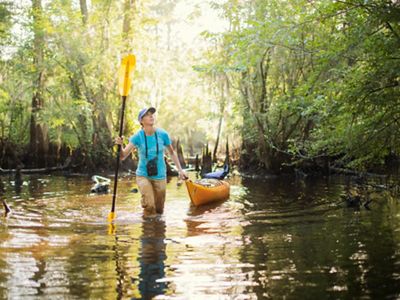
Editor’s note: Photography for this article was gathered during the normal course of annual swallow-tailed kite research. The scientists time their activities around nesting and roosting periods to minimize disturbance to the birds.
